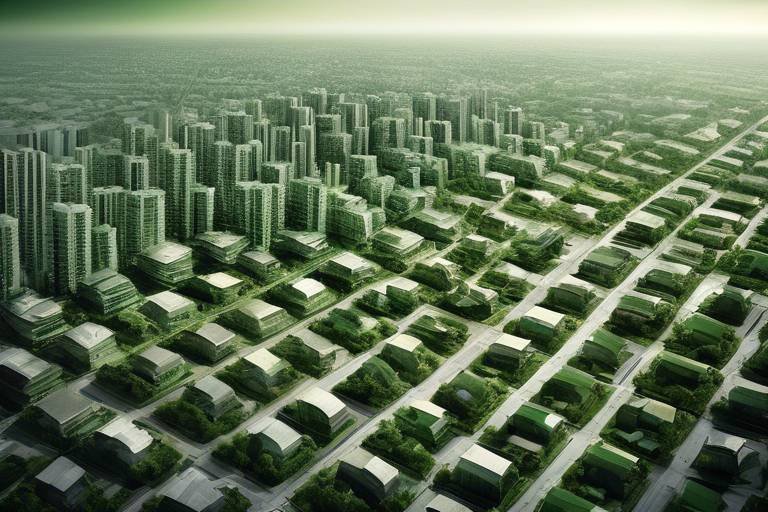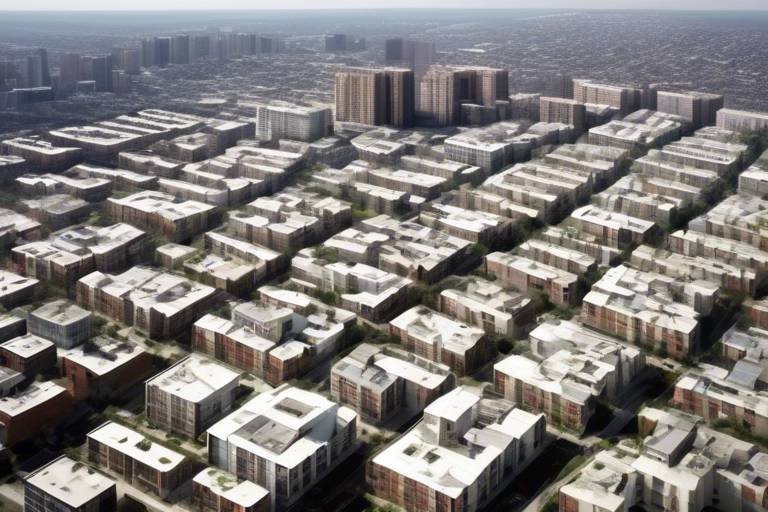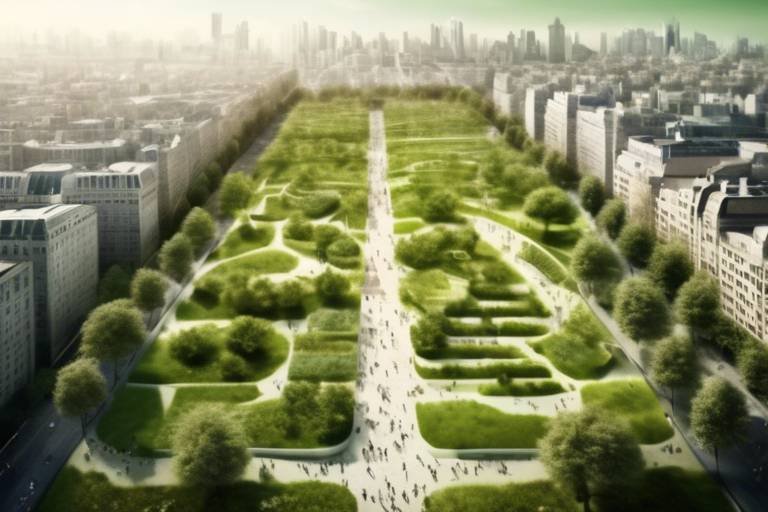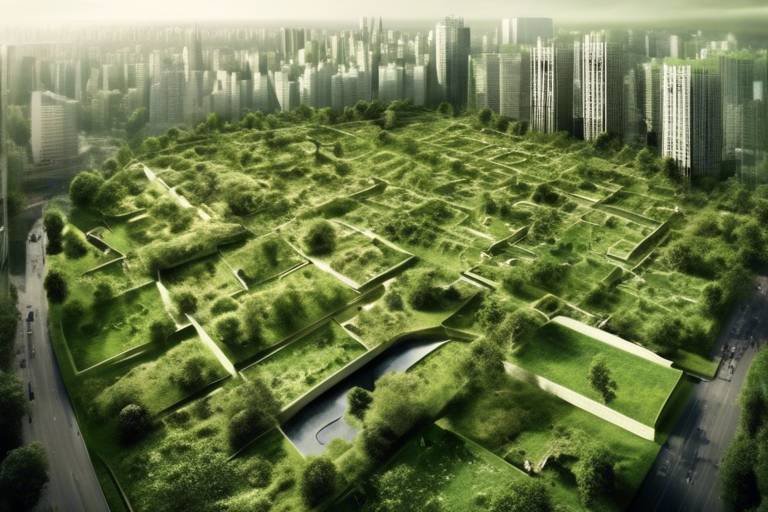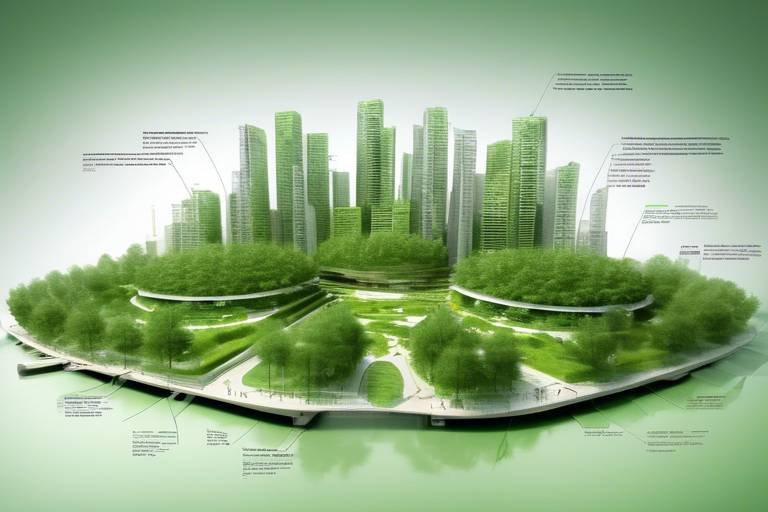The Challenge of Urban Sprawl: Can Green Building Help?
Urban sprawl is a term that often evokes images of endless highways, cookie-cutter houses, and a landscape dominated by concrete and asphalt. It's the phenomenon where cities expand outward, consuming the surrounding rural areas without much planning or foresight. This uncontrolled growth not only alters the physical landscape but also has profound implications for our environment and society as a whole. As we grapple with the consequences of this expansion, the question arises: can green building practices offer a sustainable solution to mitigate the impacts of urban sprawl?
To understand the potential of green building in addressing urban sprawl, we first need to grasp what urban sprawl entails. It typically occurs when cities grow beyond their original boundaries, leading to the development of suburban areas that are often car-dependent. This growth is fueled by various factors, including population increases, economic incentives, and a desire for larger living spaces. However, the characteristics of urban sprawl are not just about physical growth; they encompass a range of issues such as traffic congestion, environmental degradation, and social inequities.
One of the most alarming aspects of urban sprawl is its impact on the environment. As cities expand, they encroach on natural habitats, leading to habitat destruction and a decline in biodiversity. This is not just a theoretical concern; it's a reality that has significant consequences for our ecosystems. The loss of green spaces can disrupt local wildlife and diminish the natural beauty of our surroundings. Furthermore, urban sprawl contributes to increased pollution levels, as more cars on the road lead to higher emissions, and the demand for resources puts a strain on our planet.
Moreover, the relationship between urban sprawl and water resources cannot be overlooked. As cities expand, the demand for water increases, often leading to issues like runoff and pollution. Impervious surfaces such as roads and buildings prevent water from being absorbed into the ground, resulting in increased flooding and water quality problems. This not only affects the environment but also places a burden on municipal water management systems, which struggle to keep up with demand.
In addition to environmental concerns, urban sprawl also has social and economic effects. It creates disparities in access to resources and services, often leaving marginalized communities further behind. Those living in sprawling suburbs may find themselves isolated, with limited access to public transportation, healthcare, and educational opportunities. This can exacerbate inequality, creating a cycle of disadvantage that is difficult to break.
So, where does green building come into play? Green building refers to the practice of designing and constructing buildings that are environmentally responsible and resource-efficient throughout their life cycle. This includes everything from the materials used to the energy systems in place. By adopting green building practices, we can create sustainable urban environments that not only reduce the negative impacts of sprawl but also enhance the quality of life for residents.
Implementing green building techniques can lead to numerous benefits, including:
- Energy Efficiency: Green buildings often incorporate energy-efficient designs and technologies that reduce energy consumption and lower utility bills.
- Improved Air Quality: Using sustainable materials and ventilation systems can enhance indoor air quality, creating healthier living spaces.
- Enhanced Community Well-being: Green buildings can foster a sense of community and connection by creating spaces that encourage social interaction and engagement.
Innovative techniques in green building can range from using sustainable materials to implementing energy-efficient designs. For instance, buildings can be constructed with recycled materials or designed to maximize natural light, reducing the need for artificial lighting. Additionally, incorporating green roofs and urban gardens can help mitigate the urban heat island effect, further promoting environmental sustainability.
As we explore the potential of green building to combat urban sprawl, real-world examples can provide valuable insights into its effectiveness. Numerous cities around the globe have successfully implemented green building initiatives that demonstrate the positive impact of sustainable practices on urban development. These case studies not only highlight the benefits of green building but also serve as a roadmap for other communities looking to address the challenges of urban sprawl.
- What is urban sprawl? Urban sprawl is the uncontrolled expansion of urban areas into surrounding rural land, often resulting in environmental and social challenges.
- How does urban sprawl affect the environment? It leads to habitat destruction, increased pollution, and greater carbon footprints, contributing to climate change.
- What are green building practices? Green building practices focus on creating structures that are environmentally responsible and resource-efficient throughout their life cycle.
- Can green building mitigate the effects of urban sprawl? Yes, by implementing sustainable practices, green building can reduce the negative impacts of sprawl and enhance community well-being.

Understanding Urban Sprawl
Urban sprawl is like a slow-moving tidal wave, gradually swallowing up the green spaces that once defined our landscapes. This phenomenon refers to the uncontrolled and often unplanned expansion of urban areas into surrounding rural land. But what causes this phenomenon? Well, it’s a cocktail of factors including population growth, economic development, and a societal shift towards car-dependent lifestyles. As cities grow, they often do so in a way that prioritizes convenience over sustainability, leading to a patchwork of developments that can feel disjointed and chaotic.
One of the most striking characteristics of urban sprawl is the **low-density development**. Instead of building up, cities spread out, consuming vast amounts of land. This can manifest in various forms, such as sprawling suburbs, shopping malls, and industrial parks that are disconnected from one another. The implications of such growth are profound. Communities become isolated, public transport systems struggle to keep up, and the very essence of urban living is compromised.
Moreover, urban sprawl doesn’t just alter the physical landscape; it reshapes the social fabric of communities. As neighborhoods expand, the sense of community often diminishes. People find themselves further away from essential services, schools, and recreational areas, leading to increased reliance on cars. This not only contributes to traffic congestion but also raises the **carbon footprint** of urban dwellers, as more time spent on the road translates to higher emissions.
Interestingly, urban sprawl also has economic implications. While it might seem like a boon for developers, the long-term costs can be staggering. Infrastructure such as roads, utilities, and public services must stretch further to accommodate the dispersed population, leading to increased maintenance costs for local governments. In essence, sprawl can create a vicious cycle where cities become less efficient and more costly to manage.
In summary, understanding urban sprawl involves recognizing its complex causes and far-reaching consequences. It’s not just about how cities grow; it’s about how that growth affects our environment, our communities, and our way of life. As we dive deeper into the impacts of urban sprawl, we’ll see how it challenges the very foundations of sustainable living.

Impacts of Urban Sprawl
Urban sprawl is not just a buzzword; it’s a phenomenon that has tangible effects on our daily lives and the environment. As cities expand outward, they consume vast amounts of land, leading to a range of negative consequences that ripple through communities and ecosystems. One of the most immediate impacts is the increase in traffic congestion. As more people move to the outskirts in search of affordable housing, the roads become clogged with vehicles, resulting in longer commute times and heightened frustration for everyone involved. Have you ever found yourself stuck in traffic, wondering if there’s a better way to live? That’s the reality for many living in sprawling urban areas.
Moreover, urban sprawl contributes significantly to environmental degradation. The expansion into previously undeveloped land often leads to the destruction of natural habitats. This not only displaces wildlife but also diminishes the natural beauty of our landscapes. Imagine a vibrant forest turned into a parking lot; it’s a stark reminder of what we stand to lose. The consequences of this habitat destruction extend beyond aesthetics—they can lead to a decline in biodiversity, which is crucial for maintaining healthy ecosystems.
Another critical area affected by urban sprawl is social equity. As cities spread out, resources become unevenly distributed. Those living in the suburbs often find themselves isolated from essential services such as healthcare, education, and public transportation. This lack of access creates a divide, where only those with the means can afford to live in areas with better resources. It raises the question: should access to basic needs depend on where you live? The answer should be a resounding no, yet urban sprawl perpetuates this inequality.
In addition to social disparities, urban sprawl also has economic ramifications. The rush to develop new areas can lead to increased infrastructure costs. Governments are often left to foot the bill for new roads, schools, and utilities, which can strain budgets and divert funds from existing communities. It’s a vicious cycle that ultimately affects everyone, regardless of where they live. To illustrate this, consider the following table that summarizes the economic impacts of urban sprawl:
| Impact | Description |
|---|---|
| Increased Infrastructure Costs | New developments require extensive infrastructure, which can be costly for municipalities. |
| Reduced Property Values | As areas become overcrowded, property values may decline, affecting homeowners’ investments. |
| Job Accessibility | Sprawling areas may limit access to jobs, especially for those without reliable transportation. |
In summary, the impacts of urban sprawl are profound and multifaceted. From traffic woes to environmental losses and social inequities, it’s clear that unchecked urban expansion poses significant challenges. The question we must ask ourselves is: how can we pivot towards more sustainable practices that prioritize both community well-being and environmental health? As we delve deeper into the solutions, particularly through green building, we can begin to envision a future where urban sprawl is no longer the norm but a challenge we have overcome.

Environmental Consequences
Urban sprawl isn't just a buzzword; it's a phenomenon that has profound that we can no longer afford to ignore. As cities expand outward, they consume vast amounts of land, leading to the destruction of natural habitats that are vital for biodiversity. Imagine a once-thriving forest being replaced by a sprawling shopping mall or a sea of cookie-cutter houses. This loss of green space not only diminishes the beauty of our landscapes but also threatens the very ecosystems that sustain life.
One of the most alarming effects of urban sprawl is the increase in pollution levels. As more people move to the outskirts of cities, reliance on personal vehicles skyrockets, leading to traffic congestion and a significant rise in greenhouse gas emissions. The air quality in sprawling urban areas often deteriorates, which can have dire consequences for public health. According to the Environmental Protection Agency (EPA), poor air quality can lead to respiratory problems, cardiovascular diseases, and even premature death.
Moreover, urban sprawl contributes to the ever-growing carbon footprint of cities. The more we expand, the more energy we consume, particularly if our buildings are not designed with sustainability in mind. Traditional construction methods often overlook energy efficiency, leading to higher energy demands for heating, cooling, and lighting. This is where the concept of green building becomes crucial. By utilizing energy-efficient designs and renewable resources, we can significantly reduce our carbon emissions and pave the way for a more sustainable future.
Another critical aspect to consider is the impact of urban sprawl on water resources. As cities expand, they often pave over natural landscapes, which disrupts the natural water cycle. This leads to increased runoff, which can cause flooding and erosion. Furthermore, the pollutants that wash off these impervious surfaces can contaminate local water bodies, affecting both wildlife and human populations. The challenge of managing water resources becomes increasingly complex as urban areas continue to spread.
In summary, the environmental consequences of urban sprawl are extensive and multifaceted. From habitat destruction and pollution to increased carbon footprints and water management challenges, the impacts are far-reaching. To combat these issues, we must embrace sustainable practices and prioritize green building initiatives that can help restore balance to our urban ecosystems.
- What is urban sprawl? Urban sprawl refers to the uncontrolled expansion of urban areas into surrounding rural land, often characterized by low-density development.
- How does urban sprawl affect the environment? It leads to habitat destruction, increased pollution, and greater carbon footprints, which contribute to climate change and loss of biodiversity.
- What are green building practices? Green building practices involve creating structures that are environmentally responsible and resource-efficient, focusing on sustainability and energy efficiency.
- Can green building mitigate the effects of urban sprawl? Yes, implementing green building practices can help reduce pollution, conserve resources, and improve overall community well-being.

Loss of Biodiversity
As urban areas expand like a balloon being blown up, they encroach upon natural habitats, leading to a significant decline in biodiversity. This phenomenon is not just a minor inconvenience; it's a critical issue that threatens the balance of our ecosystems. When we think about biodiversity, we often picture a lush rainforest or a vibrant coral reef, teeming with life. However, urban sprawl is like a bulldozer, flattening these rich ecosystems and replacing them with concrete jungles.
The loss of biodiversity can have profound implications for our environment and, ultimately, for us. Ecosystems provide essential services such as pollination, water purification, and climate regulation. When species are lost, these services diminish, leading to a cascade of negative effects. For instance, fewer pollinators mean less food production, which can drive up prices and lead to food insecurity. It’s as if we are cutting the strings of a finely tuned instrument, throwing the entire orchestra out of harmony.
Moreover, the loss of biodiversity can lead to a decrease in resilience against environmental changes. Diverse ecosystems are more adaptable to changes such as climate fluctuations or disease outbreaks. When urban sprawl disrupts this balance, we are left vulnerable to the very challenges we are trying to mitigate. The question arises: how can we halt this relentless march of urban development and protect our precious biodiversity?
One of the most effective strategies is to integrate green spaces within urban planning. Parks, green roofs, and community gardens can serve as vital refuges for various species, allowing them to thrive amidst the urban chaos. These green spaces not only support wildlife but also provide residents with a connection to nature, which is increasingly important in our fast-paced, technology-driven world.
To illustrate the scale of biodiversity loss due to urban sprawl, consider the following table:
| Impact of Urban Sprawl | Effect on Biodiversity |
|---|---|
| Habitat Destruction | Loss of species and ecosystems |
| Pollution | Degradation of natural habitats |
| Invasive Species | Displacement of native species |
| Fragmentation of Ecosystems | Reduced genetic diversity |
In conclusion, the loss of biodiversity due to urban sprawl is a pressing issue that requires immediate attention. By adopting green building practices and prioritizing the preservation of natural habitats, we can create a more sustainable future. It’s not just about saving the trees and the bees; it’s about ensuring a healthy planet for generations to come. Are we ready to make the necessary changes, or will we continue to watch as our natural world fades away?
- What is biodiversity? Biodiversity refers to the variety of life on Earth, including the variety of species, ecosystems, and genetic diversity within species.
- Why is biodiversity important? Biodiversity is crucial for ecosystem services that support life, such as clean air and water, food production, and climate regulation.
- How does urban sprawl affect biodiversity? Urban sprawl leads to habitat destruction, pollution, and fragmentation of ecosystems, resulting in a decline in species populations and diversity.
- What can be done to protect biodiversity in urban areas? Implementing green building practices, creating parks, and preserving natural habitats can help protect biodiversity in urban settings.

Water Resource Management
Urban sprawl doesn't just stretch cities; it also stretches our vital water resources to their limits. As we pave over fields and forests to make way for new homes and businesses, we inadvertently disrupt the natural water cycle. This leads to a myriad of challenges that can affect everything from our drinking water supply to the health of local ecosystems. Have you ever wondered how much water is wasted when urban areas expand? The reality is staggering!
One of the primary issues stemming from urban sprawl is **stormwater runoff**. When rain falls on natural landscapes, the ground absorbs much of it, replenishing aquifers and nourishing plants. However, when we cover the ground with concrete and asphalt, that water has nowhere to go but straight into storm drains, often leading to pollution and erosion. This not only diminishes the quality of our water but can also lead to flooding in urban areas. The table below illustrates the impact of impervious surfaces on water management:
| Type of Surface | Water Absorption Rate | Impact on Water Resources |
|---|---|---|
| Natural Soil | High | Replenishes aquifers, reduces runoff |
| Grass | Moderate | Allows some absorption, reduces flooding risk |
| Concrete | Low | Increases runoff, contributes to pollution |
| Asphalt | Very Low | Significantly increases flooding risk |
Moreover, urban sprawl often leads to **over-extraction of water resources**. As cities grow, the demand for water skyrockets. This can lead to the depletion of local rivers, lakes, and aquifers, causing a ripple effect that impacts agriculture, wildlife, and even the climate. Imagine a world where your local river runs dry because the nearby city is consuming all its water—this is not just a hypothetical scenario; it is becoming a reality in many regions.
To tackle these pressing issues, we must adopt sustainable water resource management practices. This includes implementing **rainwater harvesting** systems, which capture and store rainwater for later use, and **green roofs**, which absorb rainwater and reduce runoff. By integrating these solutions into our urban planning, we can work towards a future where urban areas coexist harmoniously with their natural water sources.
Ultimately, managing water resources effectively in sprawling urban areas is not just a matter of infrastructure; it’s about rethinking how we design our cities. By prioritizing sustainable practices, we can mitigate the negative impacts of urban sprawl and ensure that our water resources remain plentiful for generations to come. So, what can you do to contribute to better water management in your community? Every little effort counts!
- What is urban sprawl? Urban sprawl refers to the uncontrolled expansion of urban areas into rural land, often characterized by low-density development and reliance on automobiles.
- How does urban sprawl affect water resources? Urban sprawl leads to increased stormwater runoff, over-extraction of water resources, and pollution, putting a strain on local water supplies.
- What are some solutions to manage water resources in sprawling cities? Solutions include rainwater harvesting, green roofs, permeable pavement, and sustainable urban planning practices.

Social and Economic Effects
Urban sprawl doesn’t just stretch our cities; it stretches our communities and the very fabric of our social lives. As neighborhoods expand into rural areas, the sense of community can often dissipate. Think about it: when homes are scattered over vast distances, neighbors become strangers, and social interactions dwindle. This phenomenon can lead to a feeling of isolation, particularly for those who are already marginalized. The lack of accessible public spaces and community hubs in sprawling suburbs can leave residents feeling disconnected.
Moreover, urban sprawl exacerbates economic disparities. The wealthier populations often escape to the suburbs, leaving behind urban centers that struggle with declining resources. This migration can lead to a cycle of poverty in cities as businesses close and property values drop. Without adequate investment in public services, those who remain in urban areas may find themselves with limited access to quality education, healthcare, and employment opportunities. In fact, studies have shown that sprawl can significantly hinder economic mobility, particularly for low-income families.
But it’s not all doom and gloom! There are ways to combat these social and economic effects. For instance, the development of mixed-use neighborhoods can foster a sense of community by integrating residential, commercial, and recreational spaces. This not only encourages social interactions but also supports local economies. When people can walk to shops, schools, and parks, they’re more likely to engage with their neighbors and contribute to a vibrant community life.
To illustrate the stark contrast between urban sprawl and more integrated community designs, consider the following table:
| Aspect | Urban Sprawl | Mixed-Use Development |
|---|---|---|
| Community Engagement | Low | High |
| Access to Services | Limited | Convenient |
| Transportation Needs | Car-dependent | Walkable |
| Economic Opportunities | Concentrated in suburbs | Distributed |
As we can see from the table, mixed-use developments can significantly enhance community engagement and access to services, ultimately leading to a more equitable urban environment. By prioritizing these designs, we can work towards a future where everyone has equal access to opportunities, regardless of where they live.
In conclusion, the social and economic effects of urban sprawl are profound and multifaceted. While it poses challenges, it also presents an opportunity for us to rethink how we build our cities. By embracing innovative solutions like green building and mixed-use developments, we can create urban spaces that are not only sustainable but also socially inclusive and economically vibrant.
- What is urban sprawl? Urban sprawl refers to the uncontrolled expansion of urban areas into the surrounding rural land, leading to a spread-out pattern of development.
- How does urban sprawl affect communities? It can lead to social isolation, economic disparities, and reduced access to essential services, exacerbating inequality.
- What are green building practices? Green building involves designing and constructing buildings that are environmentally responsible and resource-efficient throughout their lifecycle.
- Can mixed-use developments help combat urban sprawl? Yes! They promote community engagement and provide easier access to services, reducing the need for long commutes and fostering a sense of belonging.

Introduction to Green Building
Green building is more than just a trend; it's a vital movement aimed at creating structures that are not only functional but also environmentally responsible. Imagine living in a home that not only meets your needs but also helps to preserve the planet. That’s the essence of green building. It embodies a holistic approach to construction and design, focusing on sustainability from the ground up. This means using materials that are renewable, energy-efficient designs, and systems that minimize waste and pollution.
At its core, green building is about making choices that are better for the environment, the economy, and society as a whole. But what exactly does it involve? Here are some key principles:
- Resource Efficiency: Utilizing materials and energy wisely, reducing consumption without compromising quality.
- Indoor Environmental Quality: Ensuring that the indoor spaces are healthy and comfortable for occupants.
- Site Selection: Choosing locations that minimize environmental impact, such as avoiding sensitive ecosystems.
- Water Efficiency: Implementing systems that conserve water and manage stormwater effectively.
These principles are not just abstract concepts; they translate into real-world practices. For instance, green buildings often incorporate features like solar panels, high-efficiency HVAC systems, and sustainable landscaping. These elements work together to create a space that is not only aesthetically pleasing but also beneficial to the environment.
Moreover, green building practices can significantly reduce operational costs. By investing in energy-efficient systems, homeowners can enjoy lower utility bills over time. It's like planting a seed today for a tree that will provide shade and fruit for years to come. Plus, the enhanced air quality and natural light in these buildings contribute to the well-being of occupants, making them healthier places to live and work.
As urban areas continue to expand, integrating green building practices becomes increasingly crucial. Not only do they help mitigate the adverse effects of urban sprawl, but they also promote a sustainable future for generations to come. In the next sections, we’ll explore the myriad benefits of these practices and how they can transform our cities into greener, healthier places.

Benefits of Green Building
When we talk about green building, we're diving into a world of possibilities that not only benefit the environment but also enhance our daily lives. Imagine living in a space that not only looks good but feels good too! Green buildings are designed with the planet in mind, utilizing sustainable materials and energy-efficient technologies that reduce our carbon footprint. The benefits of these practices are numerous and can transform the way we think about urban living.
First off, let's talk about energy efficiency. Green buildings are often equipped with advanced insulation, energy-efficient windows, and smart technology that helps manage energy consumption. This means that homeowners can enjoy lower utility bills while contributing to a more sustainable future. It's like getting a double whammy of savings and environmental responsibility! According to the U.S. Green Building Council, green buildings can reduce energy consumption by up to 30% to 50% compared to traditional buildings.
But it doesn't stop there! Green buildings also promote improved air quality. By using non-toxic materials and incorporating better ventilation systems, these structures can significantly reduce indoor air pollutants. This is crucial for our health, especially for individuals with allergies or respiratory issues. Imagine walking into your home and breathing in fresh, clean air—sounds like a dream, right? Well, it can be a reality with green building practices!
Another significant benefit is the enhancement of community well-being. Green buildings often include green spaces, which can foster a sense of community and encourage outdoor activities. Parks, gardens, and communal areas not only beautify the neighborhood but also promote social interaction. It's like creating little oases in the urban jungle where people can gather, relax, and enjoy nature. Plus, studies show that access to green spaces can improve mental health and overall happiness!
Moreover, investing in green building can lead to economic advantages. As more people become aware of the benefits of sustainable living, the demand for green buildings is on the rise. This creates job opportunities in construction, design, and maintenance, boosting the local economy. Additionally, properties that are built with sustainability in mind tend to have higher resale values. It’s a win-win situation for homeowners and investors alike!
To sum it up, the benefits of green building are vast and impactful. From energy savings and improved air quality to enhanced community interaction and economic growth, these practices are paving the way for a more sustainable future. As cities continue to grow, embracing green building principles can help mitigate the effects of urban sprawl and create healthier, more vibrant communities.
- What is green building? Green building refers to the practice of creating structures that are environmentally responsible and resource-efficient throughout their life cycle.
- How does green building benefit the environment? It reduces energy consumption, lowers greenhouse gas emissions, and minimizes waste, contributing to a healthier planet.
- Are green buildings more expensive to build? While the initial investment may be higher, the long-term savings on energy and maintenance often outweigh the costs.
- Can green building improve my health? Yes! Green buildings promote better indoor air quality and provide access to natural light and green spaces, which can enhance overall well-being.

Innovative Green Building Techniques
When we think about the future of urban living, play a crucial role in shaping sustainable environments. These techniques not only address the challenges posed by urban sprawl but also enhance the quality of life for residents. Imagine living in a space that not only conserves energy but also promotes a healthier lifestyle. Sounds appealing, right? Let's dive into some of the cutting-edge practices that are transforming the landscape of urban development.
One of the most exciting advancements in green building is the use of renewable energy sources. Solar panels, for instance, can be integrated into building designs to harness the sun's power, significantly reducing reliance on fossil fuels. This not only lowers energy costs but also decreases the overall carbon footprint of the building. In fact, a well-placed solar array can generate enough electricity to power an entire home, making it a win-win situation for both the environment and homeowners.
Another innovative technique is the implementation of green roofs. These living roofs provide insulation, reduce heat absorption, and manage stormwater runoff effectively. By planting vegetation on rooftops, buildings can help mitigate the urban heat island effect, where city areas become significantly warmer than their rural surroundings. Imagine a city skyline dotted with lush greenery instead of just concrete and steel. This not only beautifies the urban landscape but also contributes to improved air quality.
Additionally, the use of sustainable materials is gaining traction in the construction industry. Materials such as reclaimed wood, recycled metal, and low-VOC (volatile organic compound) paints are becoming staples in green building projects. These materials not only minimize waste but also create healthier indoor environments. For example, using reclaimed wood not only reduces the demand for new timber but also adds a unique character to the building. It’s like giving a second life to materials that tell a story!
Water conservation is another critical aspect of innovative green building. Techniques such as rainwater harvesting and greywater recycling are becoming more common. By capturing rainwater for irrigation or reusing water from sinks and showers, buildings can drastically reduce their water consumption. This is especially important in urban areas where water scarcity is a growing concern. Just think about it—what if every building could contribute to replenishing local water supplies?
Moreover, energy-efficient appliances and smart home technology are revolutionizing how we consume energy. From smart thermostats that learn your habits to energy-efficient lighting systems, these technologies not only save money but also promote responsible energy use. It’s like having a personal assistant that helps you stay eco-friendly while making your life easier!
In conclusion, innovative green building techniques are paving the way for a more sustainable urban future. By integrating renewable energy, sustainable materials, and smart technologies, we can create spaces that not only combat the effects of urban sprawl but also enhance the quality of life for all. As we continue to innovate and adopt these practices, we move closer to achieving a harmonious balance between urban development and environmental stewardship.
- What are green buildings? Green buildings are structures designed to be environmentally responsible and resource-efficient throughout their life cycle.
- How do green building techniques help with urban sprawl? These techniques reduce resource consumption, enhance energy efficiency, and promote sustainable land use, helping to mitigate the impacts of urban sprawl.
- What are some examples of innovative green building techniques? Examples include solar energy integration, green roofs, sustainable materials, water conservation systems, and smart home technologies.
- Can green buildings save money? Yes, they can lead to significant savings on energy and water bills, as well as potential tax incentives and increased property value.
- Are there any downsides to green building? While there may be higher upfront costs, the long-term savings and environmental benefits often outweigh these initial investments.

Case Studies of Successful Green Building
When it comes to tackling the challenges posed by urban sprawl, green building initiatives have emerged as a beacon of hope. These projects not only demonstrate the feasibility of sustainable construction but also highlight the myriad benefits that such practices can bring to urban environments. Let's dive into some remarkable case studies that showcase successful green building endeavors and their positive impacts on communities.
One notable example is the Eastgate Centre in Harare, Zimbabwe. Designed by architect Mick Pearce, this shopping center is often compared to the natural cooling systems of termite mounds. Instead of relying on traditional air conditioning, the building utilizes natural ventilation and thermal mass to maintain a comfortable indoor climate. This innovative approach not only reduces energy consumption by over 90% compared to conventional buildings but also serves as a model for sustainable architecture in hot climates.
Another inspiring case is the One Central Park project in Sydney, Australia. This mixed-use development features two stunning towers adorned with vertical gardens designed by renowned landscape architect Patrick Blanc. These green walls not only enhance the aesthetic appeal of the buildings but also improve air quality and provide insulation. In addition, the project incorporates rainwater harvesting and solar energy systems, making it a prime example of how urban developments can harmonize with nature.
In the United States, the Bullitt Center in Seattle, Washington, has gained recognition as one of the greenest commercial buildings in the world. The center is designed to meet the rigorous standards of the Living Building Challenge, which requires buildings to generate their own energy, capture and treat their own water, and use sustainable materials. With features like a green roof, composting toilets, and a rainwater collection system, the Bullitt Center exemplifies how green building can redefine urban spaces while promoting environmental stewardship.
Additionally, the BedZED (Beddington Zero Energy Development) in the UK is a pioneering eco-village that emphasizes sustainability in every aspect of its design. This residential community consists of energy-efficient homes that produce more energy than they consume, thanks to solar panels and a combined heat and power system. The project also prioritizes green transportation options, encouraging residents to walk, cycle, or use public transport. BedZED serves as a testament to the potential of green building practices in creating vibrant, sustainable communities.
To further illustrate the impact of these green building initiatives, consider the following table summarizing key features and benefits of each case study:
| Project Name | Location | Key Features | Benefits |
|---|---|---|---|
| Eastgate Centre | Harare, Zimbabwe | Natural ventilation, thermal mass | 90% energy reduction |
| One Central Park | Sydney, Australia | Vertical gardens, rainwater harvesting | Improved air quality, insulation |
| Bullitt Center | Seattle, USA | Living Building Challenge compliance | Self-sufficient in energy and water |
| BedZED | UK | Energy-positive homes, green transport | Sustainable community living |
These case studies not only highlight the innovative approaches taken to address urban sprawl but also emphasize the importance of integrating sustainability into urban planning. As cities continue to grow, the lessons learned from these projects can guide future developments towards more environmentally friendly and socially equitable practices.
Q: What is green building?
A: Green building refers to the practice of designing and constructing buildings that are environmentally responsible and resource-efficient throughout their life cycle.
Q: How does green building help combat urban sprawl?
A: Green building promotes sustainable development practices that minimize land consumption, reduce pollution, and enhance community well-being, effectively mitigating the impacts of urban sprawl.
Q: Are there financial benefits to green building?
A: Yes, green buildings often lead to lower operating costs due to energy efficiency, and they can increase property values while attracting eco-conscious tenants and buyers.
Frequently Asked Questions
- What is urban sprawl?
Urban sprawl is the uncontrolled expansion of urban areas into surrounding rural land. It often leads to the development of low-density housing and can create significant challenges for infrastructure, transportation, and the environment.
- What are the main causes of urban sprawl?
Several factors contribute to urban sprawl, including population growth, economic development, and the desire for larger homes and yards. Additionally, inadequate public transportation and zoning laws can encourage spread-out development rather than compact, sustainable growth.
- How does urban sprawl impact the environment?
Urban sprawl can lead to habitat destruction, increased pollution, and a larger carbon footprint. As cities expand, natural habitats are often sacrificed for new developments, contributing to biodiversity loss and environmental degradation.
- What is green building?
Green building refers to the practice of designing and constructing buildings that are environmentally responsible and resource-efficient. This approach considers the entire lifecycle of a building, from site selection to construction, operation, and eventual demolition.
- What are the benefits of green building?
Green building offers numerous benefits, including enhanced energy efficiency, improved indoor air quality, and reduced environmental impact. Additionally, it can lead to healthier living environments and increased community well-being.
- Can green building help mitigate urban sprawl?
Yes! By promoting sustainable practices, green building can help manage urban growth more effectively. It encourages higher density developments and the use of sustainable materials, which can lessen the negative impacts of sprawl.
- What innovative techniques are used in green building?
Innovative techniques in green building include the use of renewable energy sources, sustainable materials, and energy-efficient designs. These practices not only reduce environmental impact but also enhance the overall quality of life for residents.
- Are there any successful case studies of green building?
Absolutely! Many cities have implemented successful green building initiatives that showcase the positive impact on communities and the environment. These case studies provide valuable insights into best practices and effective strategies for sustainable urban development.

